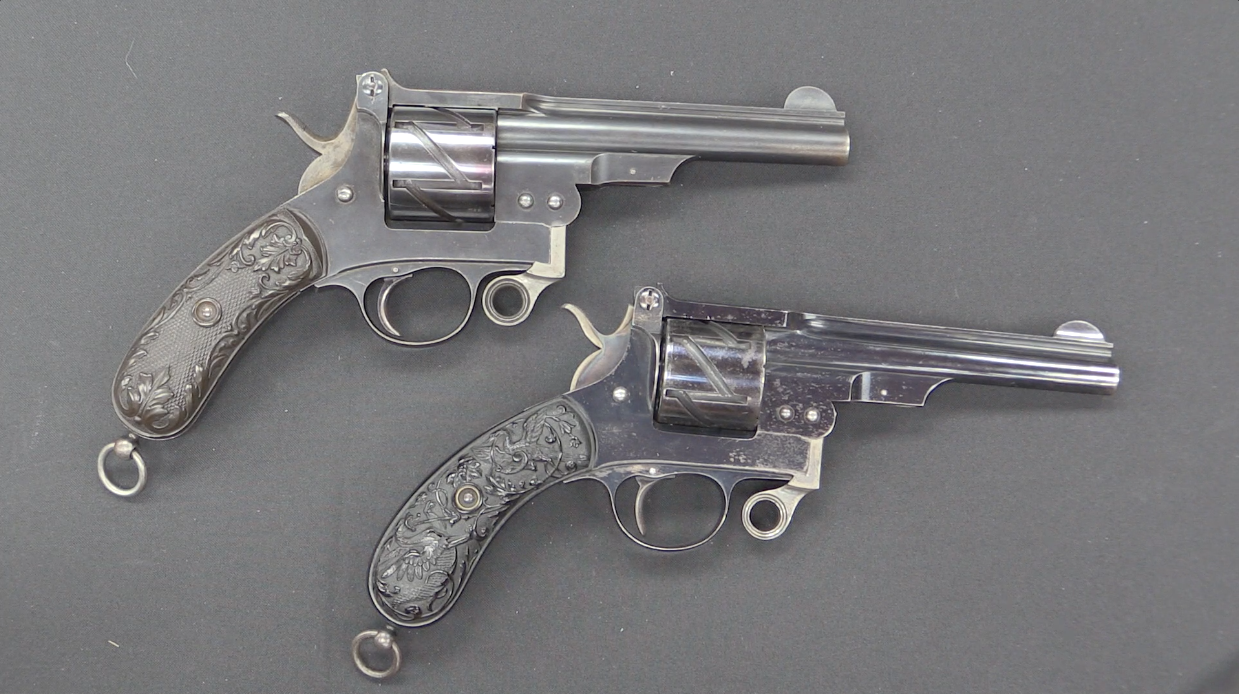I recently picked up a Walther G41 rifle (1943 production) and have been excited to have a chance to put it through a 2-Gun match. This particular rifle has clearly led an interesting life – it came all matching, but missing the magazine and bayonet lug, and with a stock that had been strangely modified (the sling cutout had been filled in with wood putty or something similar, and the wrist was cracked on both sides). In addition, while it had a G41 type mounting rail for a ZF41 optic on the rear sight, some field armorer welded on a mounting rail from a K98k. My understanding is that the G41 scope mounts never actually made it into the field, and so rigging up a K98k mount would have been the only way to actually mount a ZF41 on one of these rifles. At any rate, I find that welded-on rail to be a very interesting feature (I have a reproduction scope on order for it, but it hasn’t arrived yet).
One other issue we discovered at the match was that the stripper clip guides on this rifle have been milled out just slightly wider than they were originally made. This meant that using Romanian stripper clips was very difficult – the whole clip would slip into the magazine instead of being held in place and having the cartridges stripped off. Fortunately, Karl brought his G43 as a backup rifle, and it has a G41 bolt housing mounted in it. So we swapped housings, and that allowed us to use regular 8mm clips for the remainder of the match. When I got home I tried out some Swedish clips in my clip guides (Swedish clips are significantly wider than almost all others), and lo and behold, they work fantastically. Did someone decide to modify the rifle because the Swedish clips run more smoothly? Or because that was all they had access to? Or were they trying to disable the rifle? I have no idea.
Overall, I found the G41 to be the softest-shooting and most pleasant 8mm semiauto I’ve yet had the chance to shoot. The gas system is clearly a hindrance in the longer run, as it will eventually get dirty enough to stop working reliably. For a few hundred rounds, though, is seems to be just fine. I can absolutely see why the Wehrmacht opted to keep the basic design for the G43, with the improvements to the gas system and detachable magazines. Anyway, here’s our match footage:
For a detailed breakdown of the G41, see my previous G41 disassembly video.




Nice. For all the bad things one hears about the gas system, it ran surprisingly well. The issue with the widened stripper clip guides was just weird. Why would anyone do that?
It’s a good thing this video didn’t exist back in 1945. The Nazis might have gotten the idea to drag disabled veterans in a wheelchair back to service…
“Or were they trying to disable the rifle?”
Damaging the clip guide don’t looks like intentional disabling gun – there are more popular and more effective methods to do that, destroying firing pin for instance
“Overall, I found the G41 to be the softest-shooting and most pleasant 8mm semiauto I’ve yet had the chance to shoot.”
This sound for me like something unnecessary in military weapon.
Interesting fact: the G41(M) was even more unreliable G41(W), it was because the Mauser stick strictly to Wehrmacht requirements for rifle, for example one point was that rifle should can be operated as a bolt-action in case of automatic failure
Shooting comfort is a relevant thing, because the nicer a gun is to shoot the better you are going to shoot it once you are tired and under stress. Less flinching, faster sight picture recovery, etc.
As for reliability, I think the G41(W) may well have gotten a reputation for being worse than it actually is (and I’m probably guilty of contributing to that myself). The gas trap is certainly an inferior system, but there aren’t a lot of people out there who have actually shot them. Without any practical collective experience, the whole community tends to echo and magnify the few facts that are well known. Hence a system that must be cleaned every thousand rounds (more? less? I don’t know yet) slowly evolves into one that just doesn’t work period. It would be interesting to be able to run a significant number of rounds through a G41(M) to get a proper understanding of its behavior. I would expect it to be inferior to the (W) just based on the additional complexity and the German military choice of the (W), but you might find some interesting things by shooting one for more than a couple rounds.
Bajonet lug removed and stock openings filled up sounds very much like de-militarization as done in Germany, for example. M1 carbines had the oil-can opening in the butt closed, to name another example. Also, sights were blocked at 300 m, because greater ranges were considered to be typically military. Only after these changes the weapons could be sold as civilian semi-automatics.
Later, after a bank robbery using .22 calibre semi-automatics identified as sub-machine guns by the press, all weapons looking like full-auto models were banned. This led to banning the M1 Carbine, because it looked like the full-auto M2 Carbine as well as M14 clones, because the M14 basically was a selective-fire rifle.
What a bunch of news media know-nothings… I suppose they’d be terrified by a robber armed with nothing more deadly than an old Japanese matchlock musket with a glowing match at the touch hole.
The 300 m range is limit is a very funny thing. I mean, who in the world would like to shoot a rifle with iron sights at a longer range? It isn’t easy to hit anything that isn’t quite large, but that’s why some people like the challenge.
As for the “resembles a full auto gun”. Are all those air rifles that mimic an M16 or other assault rifle banned in Germany as well? Because certainly if a .22 lr semi-auto becomes more dangerous by just looking like a military full-auto gun, then certainly an air rifle will as well… (I am not saying that .22 lr semi-auto gun isn’t potentially dangerous in the hands of a criminal, but it is so regardless of the looks.)
The look-alike-ban was dropped in Germany a few years ago. So now you can again get a license for an Erma .22 caliber M1 Carbine replica. The pendulum swung fully and the market is flooded with semi-auto full calibre AR15 clones.
Having the good fortune to own an original matching G41(W) acquired a number of years ago at a very reasonable price I can verify that it is a pleasant rifle to shoot. However it is not a pleasant rifle to carry as it is heavy and not well balanced (muzzle heavy) in my opinion. It has a bayonet lug and you can mount the standard 98k bayonet on the rifle which makes it even worse. Mine has never malfunctioned but I do not attribute that to the gas system but rather to never having to use it in anything resembling combat. I would not think it would inspire confidence in the user. Nor would I believe it is an easy or cheap rifle to manufacture.
All in all a very interesting and fun rifle but would not be the first choice of many to carry in combat.
I’m consider my self fortunate in that i was able to handle(fondle) a G41 at a near by Cabela’s “Gun Library.” Unfortunately it was too much for my budget at the time and was soon gone. They really are a very nice rifle, and “ooze” quality. Thanks for running it for all of us to enjoy!
Personally I’d wrap that rifle stock in bandages or painters tape to keep it from being banged up so bad.
Congrats on beating Karl on two stages Ian. Do you think the G41 is softer shooting than the FG42?
Have you considered taking your Vickers to a 2 gun match and putting someone on tripod duty?
Just my two cents worth. In actual kill-and-get-killed combat it’s been my experience and observation that recoil, and muzzle blast, are minor factors. A soldier fighting for his life hardly notices either one. (Short of touching off a Boyes AT rifle or some such beast.) When the shootin’s over he may be half deaf and have a sore shoulder, but at the point of impact he hardly felt either one. On the other hand, in training one wants to reduce both to a minimum. (For instance, an FAL dialed down to just-barely-operating, with ear plugs AND earmuffs on.) This allows the trainee to master the weapon without developing a monster flinch, a flinch that will, sure as hell, carry over into combat.
I wonder why German Army requested the automatic rifle without holes for tapping gases? German technical intelligence must be aware of properly working machine guns employing gas-operated with hole mechanism (Hotchkiss 1900 and Hotchkiss Portative for example) and self-loading rifles like RSC Modele 1917, so why to prohibit this solution if it is working in practice?
Interestingly the Soviet Union from about 1930 prefer the classic gas-operated (with hole) principle in all machine-guns and auto-cannon, IIRC Soviet Ordnance officers consider it as a most reliable, because if the gas-operated gun have regulator it can be easily tuned to wide array of conditions. It must be noted that the gas-operated guns were prefer, but other was not arbitrary decline – see for example KPVT machine gun.